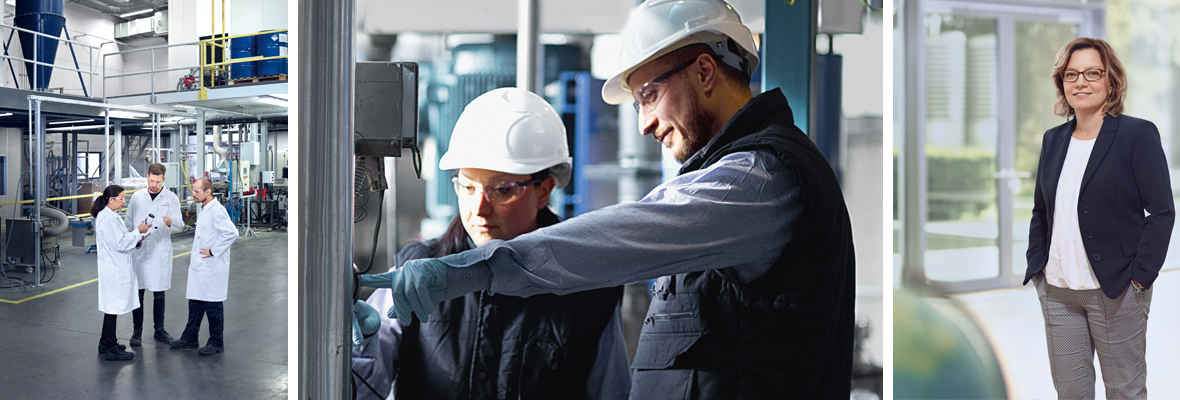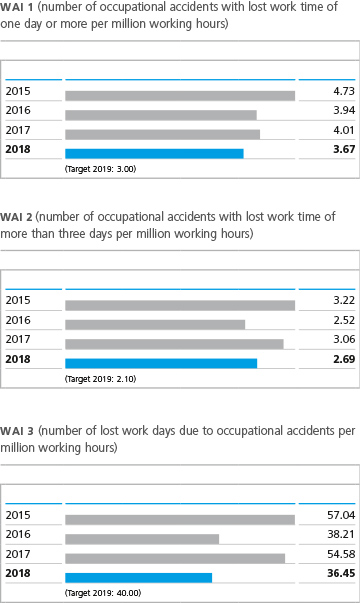Letter from the Management Board | About This Report | Sustainability Management | Corporate Governance | Corporate Bodies and Management | Report of the Supervisory Board | Creating Added Value at ALTANA | Group Management Report | Products | Safety and Health | Environment | Human Resources | Social Commitment | Consolidated Financial Statements (condensed version) | Multi-Year Overview | Global Compact: Communication on Progress (COP) | ALTANA worldwide | List of Full Ownership | Overview - About This Report | Contact
Safety and Health
ALTANA relies on a uniform safety culture. Various technical and organizational measures as well as training programs contribute to enhancing work safety and anchoring the issue firmly in our employees’ minds. Our top priority is to reduce the number of accidents. We are constantly working on minimizing hazards and improving the protection of our employees’ health.
A Focus on Occupational Safety
For ALTANA, the health and safety of employees is its top priority. Various technical and organizational measures that we implement to protect employees from hazards according to the respective sites’ production conditions as well as to the laws and regulations are in effect at each location. ALTANA also relies on training and other measures to achieve a uniform safety culture.
Since 2007, ALTANA has used the Work Accident Indicator (WAI) as the most important key performance indicator in order to observe the occupational safety at all sites and to improve it. The indicator provides the number of occupational accidents and lost work days and sets them in relation to the total working hours. On the basis of these data, ALTANA’s Management Board and the EH&S department define three WAI values each year as targets that apply to all of the companies in the ALTANA Group.
In 2018, as in the previous years, there were no fatal accidents. Some sites have achieved remarkable occupational safety results. For instance, BYK Tongling and ELANTAS Beck India at the Ankleshwar and Pimpri sites have not recorded any lost work time due to accidents for more than ten years. The following sites have been accident-free for more than six years: ECKART Zhuhai (eight years), ACTEGA Rhenacoat and ELANTAS Tongling (each seven years), and ACTEGA Foshan (six years).
Overall, ALTANA improved all of its occupational-safety key performance indicators (WAI 1, WAI 2, and WAI 3) compared to the previous year, but only partially achieved the targets it set itself in the year under review. Progress was made particularly regarding accidents with longer-term lost work time. Analyses of the accidents show that while some have technical and organizational causes, most have behavior-based causes.
To further improve this result, ALTANA will focus more on safety culture in the future. In addition to the further development of technical and organizational measures, behavior-based safety training serves to sharpen employees’ awareness of safety issues and train them to act safely 100 percent of the time.
In addition, ALTANA published a newsletter titled SAFETY @ ALTANA for the first time in 2018 and distributed it to all its worldwide sites. In the newsletter, accidents with significant frequency and relevance, for example stumbling, slipping, and falling are addressed and recommended actions are provided. Furthermore, ALTANA’s staff magazine regularly discusses special accidents and strategies for avoiding them. Moreover, all sites have established efficient processes for prompt analyses of accidents in which employees and managers are involved.
Incidents in Detail
Based on the instructions for reporting on globally harmonized process safety key figures in accordance with the International Council of Chemical Associations (ICCA) and on the definition provided by the German Chemical Industry Association (VCI), we had a total of eleven significant incidents in 2018 (previous year: 12). No employees were injured. The eleven incidents were releases of chemicals. They did not have negative effects on the environment. There were no fires or explosions in the period under review.
Worldwide Safety Measures
At most sites, a safety week is held on an annual basis. All employees at the respective sites are invited to engage with the issue of safety within the framework of seminars and presentations. For example, special safety trainings were carried out at different sites of ELANTAS Europe, at ACTEGA North America, and at ACTEGA do Brasil.
To avoid accidents with forklifts, some sites have equipped their vehicles with so-called blue lights. The lights, mounted on the front and back of the vehicles, cast a bright blue spot on the ground, enabling pedestrians and other drivers of vehicles to see the forklift from a distance, especially in areas with poor visibility.
The company suggestion scheme (CSS) continues to play a key role in the improvement of ALTANA’s safety culture. More than 200 ideas concerned the subject of “Improvement of safety at the workplace and of health protection.” The suggestions that were implemented not only helped improve ergonomic conditions and occupational safety but also helped cut costs.
A Focus on Safety Communication
To continue to sharpen safety awareness in the long term, the ALTANA Group primarily relies on targeted communication.
Last year, BYK in Germany signed a multiyear cooperation agreement with the employer’s liability insurance association of raw materials and chemical industry (BG RCI) titled “VISION ZERO. Zero Accidents – Healthy Work!” Accompanying this, the safety campaign “Together. For Safety. VISION ZERO” was launched in 2018. In this context, all managers attended a one-day workshop at which the seven VISION ZERO success factors were explained. For example, the success factor “Danger recognized – danger banned” was elucidated in detail. Within the framework of the cooperation, every year measures are jointly defined and implemented in practice.
At the ACTEGA site in Grevenbroich, a special kind of coaching on the topic of “Behavior-based safety culture” was carried out with an external partner. The aim of this concept is to bring about a lasting change in employees’ safety awareness. In addition to other issues, the focus was on the topic of “self-motivated and self-dependent action.” Given the very positive response, we will carry out this type of coaching or comparable kinds at other sites as well, in order to continuously improve employees’ safety behavior there.
Health Protection
To improve health protection, investments were made to reduce volatile organic compounds (VOCs) in the room air of production buildings. BYK in Kempen, the ELANTAS sites in Hamburg, Quattordio, and Zhuhai, ACTEGA in Foshan, and ECKART in Güntersthal made great progress in this endeavor in the year under review. With the help of closed systems, optimized exhaust systems, and automation measures the corresponding emissions were reduced considerably.
Ergonomic conditions were improved at a number of sites. For instance, loading and lifting facilities for various work processes involving heavy containers and apparatus were set up at the ECKART sites in Painesville, Louisville, Pori, and Güntersthal, as well as at the ELANTAS site in Quattordio. As a result, manual activities were reduced and musculoskeletal disorders minimized.
At many sites around the world, annual health days have been established, on which employees can get medical checkups and obtain information about healthy nutrition. For example, the ELANTAS site in Hamburg offers employees additionally cardiovascular and thyroid examinations.
Moreover, employees around the world have access to a manifold sports, nutrition, fitness, and relaxation offer, which at many sites is available all year round.

